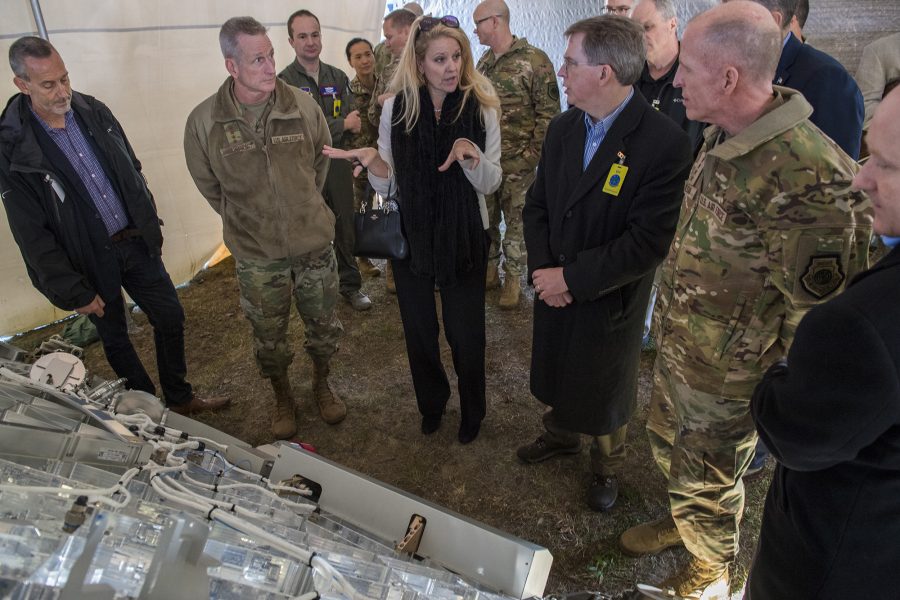Two Air Force officials say they and their counterparts in the other services will dig into joint operating concepts for command and control following a Pentagon-wide gathering on the topic in mid-January.
“We really looked at structure, processes, and challenges and opportunities, and that’s probably the best way to describe the outcomes of the C2 summit this time, as we looked at the need for what joint operating concepts the services need to develop,” Air Combat Command Operations Director Maj. Gen. Kevin Huyck said.
Joint All-Domain Command and Control, or JADC2, is the idea that any sensor can connect to any weapon system, regardless of which armed force owns it, to act as quickly as possible in combat. As others focus on the technology side of JADC2, this group of military policymakers has to come up with the tactics, techniques, and procedures that will guide how service members use their hyperconnected tools.
Officials acknowledge there’s more work that needs to happen so different systems using a range of software languages can share their data. Experiments are underway to flesh that out, like the Advanced Battle Management System tests and others at the Shadow Operations Center at Nellis Air Force Base, Nevada.
But there’s a growing sense within the Defense Department that they don’t have to wait to make progress.
“That’s a real concrete takeaway from these discussions, is you realize there are things that we can do now,” Huyck said. “There is information out there. We may need to translate data in the interim, but as long as we can affect data transferring from someone who finds a target to someone who can actually fire on the target or create an effect or do long-range precision fire … that’s a great advancement.”
The Shadow OC has evolved over the past few years into a testbed that lets the services practice new command and control concepts. It hosted an experiment in October and is planning another large demonstration in March, according to Maj. Gen. Charles Corcoran, head of the Air Force Warfare Center at Nellis.
The Joint Requirements Oversight Council, the high-level body chaired by the vice chairman of the Joint Chiefs of Staff that approves the capabilities of military systems, will direct the demo. Each service will participate at the operational level, Corcoran said.
Between bigger events, Airmen are using smaller training to figure out how to share data between assets and looking at those concepts during operational testing. JADC2 has also found its way into the integration phase at the end of each six-month Weapons School term, it is starting to shape Red Flag exercises, and is institutionalizing USAF participation in the Naval Aviation Warfighting Development Center’s strike group training.
“It’s about the planning and the preparation … all the way back down to the unit level,” Huyck said. “When you have the tactical experts that understand … how the information, the zeros and ones, are being transferred between the weapons systems, they can put the sensor in the right place, they can figure out what shooters need to be on the air tasking order, so when it comes time to do it for real in combat, they’ve already exercised with each other.”
For example, the services have to craft protocols for finding the fastest and most effective way to track a moving target while trying to pin it down.
The USAF officials stressed the need for people across the armed forces to understand how other services talk about a situation. That doesn’t necessarily mean creating one universal set of terms for how the Pentagon wages war, but instead giving service members a broader lexicon.
“Just understanding who’s in charge of the battlespace, and the call signs of the various C2 entities on the radio and who you’re talking to, saves a lot of time and effort if you really get into a shooting war,” Corcoran said. “If I’m going to go out as an Airman, and support the strike group, whether it’s with ISR, or strike assets, etc. … I’ve got to know the lingo that they’re speaking to be able to provide them the seamless, timely support that they need.”
That notion isn’t new, but the urgency behind it is. Vice Chairman of the Joint Chiefs of Staff Gen. John Hyten said Jan. 29 at an Air Force Association breakfast that figuring out the data issues underlying JADC2 will be “the most important thing … we do as a joint force.”
His JROC is in the process of sketching out the requirements for the next-generation command and control. The Joint Staff is also crafting the joint warfighting concept for how the assets would be used in the coming decades, including the new Space Force and U.S. Space Command. A plan is due to the Defense Secretary in December.
The JROC met the week of Jan. 27 with the service vice chiefs and other senior defense officials to discuss how the top-level board can drive systems integration.
“It is not going to be a list of performance criteria that you have to do 10 years from now,” he said. “That’s how we’ve been building requirements. … It’s going to focus on how we build things, focus on incorporating innovation in the services, innovation in industry. And by doing that, we have to actually push things down and allow for flexibility in development, flexibility in operations, flexibility in test.”

